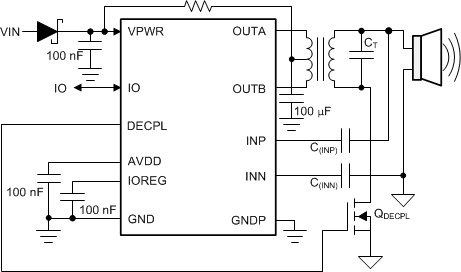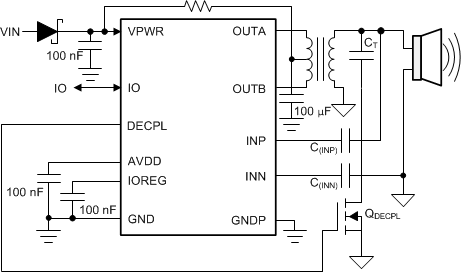SLASEC8C February 2017 – February 2023 PGA460-Q1
PRODUCTION DATA
- 1 Features
- 2 Applications
- 3 Description
- 4 Revision History
- 5 Pin Configuration and Functions
-
6 Specifications
- 6.1 Absolute Maximum Ratings
- 6.2 ESD Ratings
- 6.3 Recommended Operating Conditions
- 6.4 Thermal Information
- 6.5 Internal Supply Regulators Characteristics
- 6.6 Transducer Driver Characteristics
- 6.7 Transducer Receiver Characteristics
- 6.8 Analog to Digital Converter Characteristics
- 6.9 Digital Signal Processing Characteristics
- 6.10 Temperature Sensor Characteristics
- 6.11 High-Voltage I/O Characteristics
- 6.12 Digital I/O Characteristics
- 6.13 EEPROM Characteristics
- 6.14 Timing Requirements
- 6.15 Switching Characteristics
- 6.16 Typical Characteristics
-
7 Detailed Description
- 7.1 Overview
- 7.2 Functional Block Diagram
- 7.3
Feature Description
- 7.3.1 Power-Supply Block
- 7.3.2 Burst Generation
- 7.3.3 Analog Front-End
- 7.3.4 Digital Signal Processing
- 7.3.5 System Diagnostics
- 7.3.6
Interface Description
- 7.3.6.1 Time-Command Interface
- 7.3.6.2
USART Interface
- 7.3.6.2.1 USART Asynchronous Mode
- 7.3.6.2.2 One-Wire UART Interface
- 7.3.6.2.3 Ultrasonic Object Detection Through UART Operations
- 7.3.6.3 In-System IO-Pin Interface Selection
- 7.3.7 Echo Data Dump
- 7.3.8 Low-Power Mode
- 7.3.9 Transducer Time and Temperature Decoupling
- 7.3.10 Memory CRC Calculation
- 7.3.11 Temperature Sensor and Temperature Data-Path
- 7.3.12 TEST Pin Functionality
- 7.4 Device Functional Modes
- 7.5 Programming
- 7.6 Register Maps
- 8 Application and Implementation
- 9 Device and Documentation Support
- 10Mechanical, Packaging, and Orderable Information
Package Options
Mechanical Data (Package|Pins)
- PW|16
Thermal pad, mechanical data (Package|Pins)
Orderable Information
7.3.9.2 Temperature Decoupling
Similarly to time decoupling, a temperature-decoupling function has been implemented in the PGA460-Q1 device that can connect and disconnect a temperature-compensation capacitor at a certain temperature point to compensate for the temperature nonlinearity of the transducer. By using this function, the transducer frequency is assumed to remain within limits across temperature. To enable this function, the DECPL_TEMP_SEL bit must be set to 1.
Upon receiving a run command, the PGA460-Q1 device executes the TEMPERATURE MEASUREMENT command first and compares the result with the temperature setting defined by the DECPL_T bit in the EEPROM. If the temperature measured is higher than the value based on the DECPL_T bit, then the DECPL pin is low (GND) causing the QDECPL transistor to be disabled and the temperature compensation capacitor to disconnect. If the measured temperature is less than the value based on the DECPL_T bit, the DECPL pin is high (3.3 V or 5 V depending on the IOREG level), the QDECPL transistor is enabled and the temperature compensation capacitor is connected to the circuit. #X769 shows the circuit implementation.
 Figure 7-37 Transducer Time Decoupling
Figure 7-37 Transducer Time Decoupling Figure 7-38 Transducer Temperature Decoupling
Figure 7-38 Transducer Temperature Decoupling